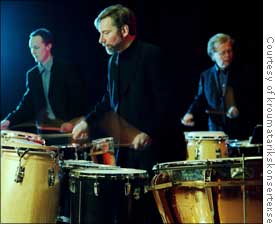
| << Front page | Arts | April 7, 2006 |
Percussionists Amaze with Variety
 |
||
| Scandinavian sensation: The Swedish percussion ensemble Kroumata pounded Finney on Thursday. | ||
Last night, the Swedish percussion ensemble Kroumata performed, marking the sixth of seven installments in the Oberlin Artist Recital Series. Finney Chapel was not as full as it has been at some of the other concerts in the series, but the fine, spirited musicians of the ensemble were met by an equally spirited audience, and they gave highly nuanced performances of a diverse body of works.
“We like contrast,” explained one of the five musicians while the stage was being reset for the second piece, and that was certainly evident. The first work on the program was John Cage’s “Third Construction,” composed in 1941. It was made up mostly of loud, driving rhythmic figures on unpitched instruments. The next piece, Swedish composer Arne Mellnas’s “Fragile,” was, on the other hand, a slow, arrhythmic, ethereal piece for pitched instruments — bowed crotales and marimba, a wine glass and two synthesizers. It could not have been any more different from the Cage.
Unless, of course, it was “Trad (Forest of Hands)” by the group’s absent sixth member, John Eriksson, a piece for one marimba with four players, plus extra marimba bars offstage. This piece, meant to represent the sounds of tree branches moving against each other, was genuinely beautiful. It began with a two note figure in the high register of the marimba echoed by the offstage performer, with a low rumbling accompaniment produced by the other three players. The music gradually evolved to a pulsating major chord with embellishment, and eventually to a single note.
Or else there was their encore, a fun ragtime tune for xylophone solo with two marimbas and a drum set playing accompaniment. “Okho” by Romanian/Greek composer Iannis Xenakis was also exciting — originally written for three African djembes, but performed by Kroumata on Peruvian Cajuns and wooden boxes that the performers sat on and hit, knocked, tapped and kicked in a variety of places yielded a variety of sounds and a very compelling visual performance that must have required a great deal of coordination to pull off (think a high school step squad, only with middle-aged Swedish men). There was also “She came, She went” by Morgan Agren, another Swede, a quirky piece heavily influenced by the composer’s idol, Frank Zappa.
Equally exciting as the variety between the pieces was the variety of strange instruments used, from a conch shell in the Cage to a theremin in the Agren to a toy piano in the final piece on the program, “Schlagmusik 2” by German composer Georg Katzer.
The Katzer was the weak point on the program — it tried to do too much. After an extended section of relatively normal playing, including some very interesting textures, the piece broke down into a piece of theatrics, featuring talking, a magic trick, and flirtatious exchanges between the musicians while playing slide whistles.
At one point, four of the performers were clustered around a marimba playing while the fifth blew a whistle, indicating that the performers should switch positions. This was a clever device, as some of the performers had bows while some had mallets, meaning different registers of the instrument were being played differently when they switched, but it was gone about in a bad way. The section of relatively normal playing that closed the piece lost much of its credibility coming after the silly middle section.
In all, though, Kroumata gave a brilliant performance, showing that even the most stereotypically noisy percussion instruments can be played in a musical, expressive way. In a master class with the Oberlin percussion department the previous night, the musicians worked toward that goal. Revealing themselves to be nice, easy-to-work-with people, Kroumata tried to bring out subtle details in the students’ playing. The main focus of the master class was Xenakis’s monumental “Persephassa” for six players, which will be performed by the Oberlin Percussion Ensemble later this semester.
Kroumata’s concert was introduced by Conservatory Dean David Stull, who
announced the artists on next year’s recital series. Scheduled to come are
the Emerson String Quartet, singer Juan Diego Florez, the American Brass
Quintet, the Cleveland Symphony, the New York Woodwind Quintet, pianist Jonathan
Biss, and violinist Gil Shaham.
About us
Subscriptions
Advertising